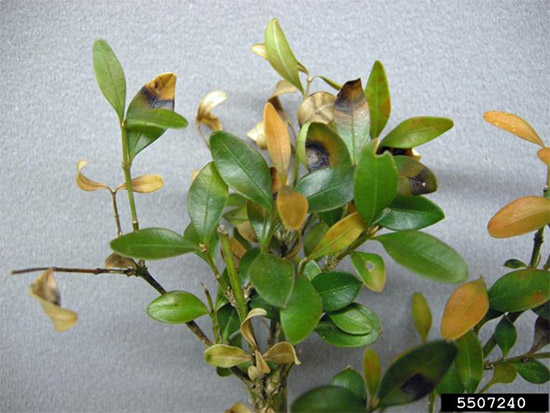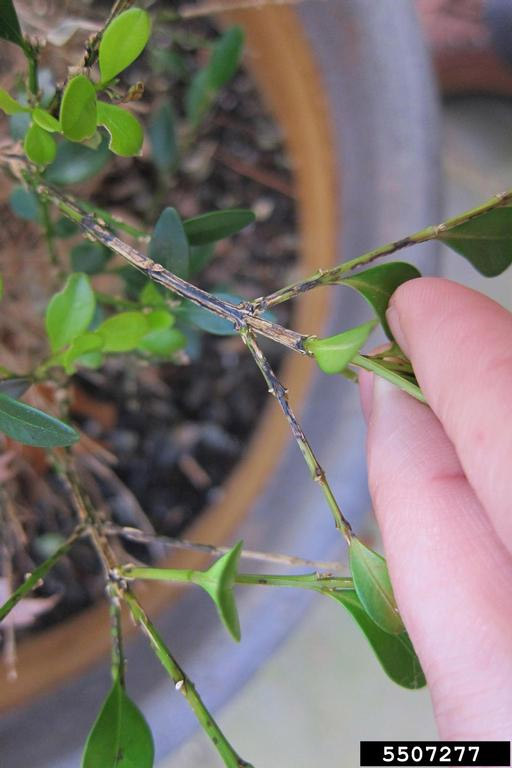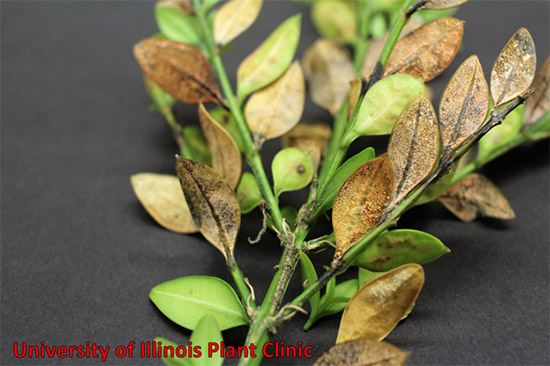Issue 4, May 16, 2016
Brown Boxwoods
Each spring we receive questions and concerns regarding browning boxwoods. The browing foliage is often the result of winter injury, and weak pathogens infecting the winter injured tissues. More recently, however, callers have been concerned about Boxwood Blight, a new and devastating disease to boxwood. Boxwood blight has been identified in 18 states, mostly along the eastern seaboard and Oregon. In the Midwest, it has been confirmed in Ohio and Missouri. To date, Boxwood Blight has not been detected in Illinois. However, this disease is considered a threat to Illinois. Please contact us if you see a suspect plant. Key identification characteristics of Boxwood Blight and its look-alikes are provided below.
Boxwood Blight (Calonectria pseudonaviculata, syn. Cylindrocladium buxicola)
Hosts are limited to the Buxaceae family, including boxwood and pachysandra. Boxwood species vary in their susceptibility. Buxus sempervirirens and cultivars are the most susceptible, while Buxus sinica var. insularis, Buxus microphylla and their cultivars have been noted to be more resistant. While resistant cultivars show fewer symptoms, they can still spread the pathogen, an may act as a 'Trojan Horse," introducting the pathgoen to new loacations.
Look for these characteristic symptoms of Boxwood Blight:
- Dark brown or black, circular leaf spots (Photo 1)
- Dark brown or black linear stem cankers (Photo 2)
- Complete defoliation of the plant.
- White fungal sporulation on the undersides of the leaves.
**Many of these symptoms are similar to other diseases. Diagnosis should be confirmed by a plant diagnostic laboratory, such as the Univseristy of Illinois Plant Clinic

Photo 1. Leaf spots caused by boxwood blight. Photo Credit: Mary Ann Hansen, Virginia Polytechnic Institute and State University, Bugwood.org

Photo 2. Boxwood Blight. Black linear stem cankers. Photo Credit: Adria Bordas, Virginia Polytechnic Institute and State University, Bugwood.org
Boxwood Blight Look-alikes
Winter Injury, Macrophoma Leaf Spot, and Volutella Blight are common problems of boxwoods grown in Illinois. Their symptoms have similarities to those of Boxwood Blight. To manage these diseases, prune out dead tissues in the spring, preferably during dry weather. Lightly thin the plant so that there is good air circulation within the canopy. Remove all dead leaves and fallen leaves from around the plant. Take steps to avoid winter injury. Protect boxwoods from desiccating winter winds and intense sunlight.
Winter Injury (Abiotic)
Winter injury occurs as cold, dry, winter winds and/or direct sunlight causes moisture loss from the evergreen leaves. Frozen soils prevent the plant from taking up water and freeze-dried burn symptoms often result. Depending on a plant's hardiness, location, and the weather conditions, winter injury can damage the entire plant or just the branch or leaf tips causing leaves to become pale yellow/reddish bronze. The pattern of injury can also be helpful in diagnosing winter injury. Injury is most likely to occur on southwest and windward facing sides of the plant. A "snow line," or distinct line that separates the healthy green bottom from the damaged brown top can also be an indication of winter injury. Snow insulates and protects foliage from desiccating winds and extreme cold temperature.
Macrophoma Leaf Spot (Macrophoma candollei)
Macrophoma is a weak pathogen that can be confused with Boxwood blight. The disease causes leaf spots and straw colored leaves and can be easily identified by the numerous black, raised fruiting bodies found on dead or dying leaves (Photo 3).

Photo 3. Black, raised fruiting bodies of Macrophoma Leaf Spot on boxwood.
Volutella Blight (Volutella buxii (asexual stage of Pseudonectria rouselliana))

Photo 4. Volutella Blight with salmon colored sporulation.
This fungal pathogen often infects wounds resulting from winter injury. Infected leaves on branch tips turn tan, straw-yellow or bronze color in the spring. Volutella often moves down the stem, whereas winter injury happens seemingly at once and does not progress down the stem. Under moist, humid conditions, the foliage may develop distinct masses of pink to salmon colored spores (Photo 4). (Travis Cleveland)
Author:
Travis Cleveland